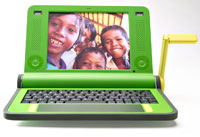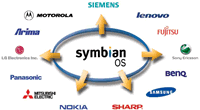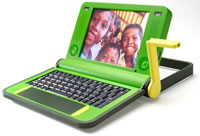 The $100 laptop project launched by MIT Media Lab, gained a big boost yesterday when the labs Nicholas Negroponte met with UN Secretary-General Kofi Annan at the World Summit on the Information Society in Tunisia.
The $100 laptop project launched by MIT Media Lab, gained a big boost yesterday when the labs Nicholas Negroponte met with UN Secretary-General Kofi Annan at the World Summit on the Information Society in Tunisia.
Kofi Annan opening address summed up the project and its hopes succinctly, “The true meaning of one laptop per child, is not a matter of just giving a laptop to a child, as if bestowing on them some magic charm. The magic lies within. Within each child there is a scientist, scholar, or just plain citizen in the making. This initiative is design to bring it forth into the light of day.”
No right thinking individual could possibly doubt the value of this project. There may be a lot of commercial concerns, but we’ll get to that later on.
The Specs
It will be Linux-based, full-colour laptop that uses a wind-up handle as a power source. Run at 500MHz, with 1GB of memory and a built in 1 Megapixel camera it should run most applications that could be required (remember Linux doesn’t suck up a lot of the processors power). Just the laptop screen alone is expected to cost around $35, pretty good when a screen on a laptop is normally $150 alone.
 “USB ports galore” will be provided as will built-in WiFi. The only thing it will be missing is a hard drive. We’d imagine that this will be down to the additional power drain they have, and to try and maintain the necessary ruggedness. The networking will be via a wireless mesh.
“USB ports galore” will be provided as will built-in WiFi. The only thing it will be missing is a hard drive. We’d imagine that this will be down to the additional power drain they have, and to try and maintain the necessary ruggedness. The networking will be via a wireless mesh.
The driving theory of the project is that Learning is seamless – not just something that you do at school. This has lead to the need for an adaptable design, enabling it to be used as an electronic book (with the fingers at the back controlling the cursor), a games machine, TV set and, of course, laptop.
 All software will be open source as in Negroponte view “open source software is the key to innovation in software and learning technology.”
All software will be open source as in Negroponte view “open source software is the key to innovation in software and learning technology.”
It’s been reported that Steve Jobs had offered Apple OSX for nothing for use in the project, but it was turned down as it wasn’t open source.
Availability and impact
The laptops will be financed though domestic resources (ie the countries government), donors, and what was rather mysteriously described as “other arrangements.” It will be at no cost to the recipients themselves.
The current plans call for producing five to ten million units near the start of late 2006 or early 2007, launching in six countries. Not bad considering that Negroponte first publicly announced it in January 2005. The promise is to bring the price down at each technical advance.
Negroponte spoke about “the same laptop being commercially available, at say $200” for small businesses. They hope to announce the construction partners soon.
 The impact of this project could be huge on many fronts – if it comes into being – and we’ve no reason to imagine that it won’t. Giving any and every child access to a computer, and teaching them to use it and inspiring them will be the start of a revolution bring free communication and equal learning to all citizens.
The impact of this project could be huge on many fronts – if it comes into being – and we’ve no reason to imagine that it won’t. Giving any and every child access to a computer, and teaching them to use it and inspiring them will be the start of a revolution bring free communication and equal learning to all citizens.
We don’t think that the impact will stop there. If the world is aware that there are laptops, perfectly able to carry out most daily required computing functions, that only cost $100, why would anyone want to pay for other ‘full price’ machines? The impact on the supply of hardware in the part of the world that already has computers will be huge.
All power to this project. Let’s help technology change the world for the better.
MIT Media Lab One Laptop Per Child
Watch the Launch video(Real video)
 We spent a thoroughly stimulating day at the press opening of the Royal College of Art yesterday for their end of year show.
We spent a thoroughly stimulating day at the press opening of the Royal College of Art yesterday for their end of year show. English computing stalwarts, RM announced that they have the exclusive contract to distribute new HP 2133 Mini-Note PC to schools, colleges and universities in the UK.
English computing stalwarts, RM announced that they have the exclusive contract to distribute new HP 2133 Mini-Note PC to schools, colleges and universities in the UK. A new report examining the role computer and video games can play in education was released today by ELSPA (the Entertainment and Leisure Software Publishers Association), in association with the UK Department for Education and Skills’.
A new report examining the role computer and video games can play in education was released today by ELSPA (the Entertainment and Leisure Software Publishers Association), in association with the UK Department for Education and Skills’. Some will find it surprising that it’s not just young joystick twitchers that are benefiting from learning through games. E-learning expert, Professor Stephen Heppell, who has been studying this area for years explained, “The curious thing is that we’re seeing people playing games and challenging themselves with their computers right across the age range, literally womb to tomb. (We take our hat off to him for being the first person to use the ‘Womb to Tomb’ phrase, which, from this point forward, we will never tire of using.)
Some will find it surprising that it’s not just young joystick twitchers that are benefiting from learning through games. E-learning expert, Professor Stephen Heppell, who has been studying this area for years explained, “The curious thing is that we’re seeing people playing games and challenging themselves with their computers right across the age range, literally womb to tomb. (We take our hat off to him for being the first person to use the ‘Womb to Tomb’ phrase, which, from this point forward, we will never tire of using.) Desktop computing will be dead by the end of the decade and laptops will be following shortly after. That was the view of Graham Brown-Martin of Handheld Learning in an entertaining presentation at day two of the EIEF.
Desktop computing will be dead by the end of the decade and laptops will be following shortly after. That was the view of Graham Brown-Martin of Handheld Learning in an entertaining presentation at day two of the EIEF. As an illustration of this, and of his extremely cool mobile phone, Brown-Martin demonstrated a home made remix of the Snakes on a Plane teaser, edited with a mobile and a Macbook. The result was uploaded directly to YouTube from the phone then downloaded again (wirelessly) using a Nokia Internet tablet.
As an illustration of this, and of his extremely cool mobile phone, Brown-Martin demonstrated a home made remix of the Snakes on a Plane teaser, edited with a mobile and a Macbook. The result was uploaded directly to YouTube from the phone then downloaded again (wirelessly) using a Nokia Internet tablet. Yesterday, a spokesperson for the One Laptop Per Child (OLPC) programme revealed that Nigeria, Brazil, Argentina, and Thailand have all tendered commitments to purchase one million Linux laptops through the ambitious US-based programme.
Yesterday, a spokesperson for the One Laptop Per Child (OLPC) programme revealed that Nigeria, Brazil, Argentina, and Thailand have all tendered commitments to purchase one million Linux laptops through the ambitious US-based programme. This means that each laptop will be able to talk to its nearest neighbour and create ad hoc, local area networks for sharing data and connections.
This means that each laptop will be able to talk to its nearest neighbour and create ad hoc, local area networks for sharing data and connections. So far, AMD, eBay, Google, Nortel, Red Hat, and a number of other technology companies have all signed up to help support the project
So far, AMD, eBay, Google, Nortel, Red Hat, and a number of other technology companies have all signed up to help support the project Symbian, the smartphone OS company, are pulling a smart move (pun intended) by offering free assistance to Universities and their lecturers to have Symbian programming skills built into courses. Very clever.
Symbian, the smartphone OS company, are pulling a smart move (pun intended) by offering free assistance to Universities and their lecturers to have Symbian programming skills built into courses. Very clever. As a sweetener to the lecturers to get involved, Symbian will provide “exposure to Symbian’s industry partners.” Pretty healthy if you fancy running a software development company and want to get exposure for your potential products, or you’re getting a little bored of Uni life and fancy impressing those in industry that you’re a bit of visionary.
As a sweetener to the lecturers to get involved, Symbian will provide “exposure to Symbian’s industry partners.” Pretty healthy if you fancy running a software development company and want to get exposure for your potential products, or you’re getting a little bored of Uni life and fancy impressing those in industry that you’re a bit of visionary. All of those children who have been struggling to get their parents to buy them the playground-must-have, an iPod, now have the ultimate excuse – “But it’s for my edukashon!”
All of those children who have been struggling to get their parents to buy them the playground-must-have, an iPod, now have the ultimate excuse – “But it’s for my edukashon!” Deja Vu
Deja Vu Students will be able to download study guides that work with Pearson’s educational texts and listen to review notes to prepare for exams.
Students will be able to download study guides that work with Pearson’s educational texts and listen to review notes to prepare for exams. Apple has used this approach previously. Many years ago Apple started selling their computers to school children at a discount, with the logic that if they were hooked early, they’d be in the Apple-way for the rest of their lives.
Apple has used this approach previously. Many years ago Apple started selling their computers to school children at a discount, with the logic that if they were hooked early, they’d be in the Apple-way for the rest of their lives. The $100 laptop project launched by MIT Media Lab, gained a big boost yesterday when the labs Nicholas Negroponte met with UN Secretary-General Kofi Annan at the World Summit on the Information Society in Tunisia.
The $100 laptop project launched by MIT Media Lab, gained a big boost yesterday when the labs Nicholas Negroponte met with UN Secretary-General Kofi Annan at the World Summit on the Information Society in Tunisia. “USB ports galore” will be provided as will built-in WiFi. The only thing it will be missing is a hard drive. We’d imagine that this will be down to the additional power drain they have, and to try and maintain the necessary ruggedness. The networking will be via a wireless mesh.
“USB ports galore” will be provided as will built-in WiFi. The only thing it will be missing is a hard drive. We’d imagine that this will be down to the additional power drain they have, and to try and maintain the necessary ruggedness. The networking will be via a wireless mesh. All software will be open source as in Negroponte view “open source software is the key to innovation in software and learning technology.”
All software will be open source as in Negroponte view “open source software is the key to innovation in software and learning technology.” The impact of this project could be huge on many fronts – if it comes into being – and we’ve no reason to imagine that it won’t. Giving any and every child access to a computer, and teaching them to use it and inspiring them will be the start of a revolution bring free communication and equal learning to all citizens.
The impact of this project could be huge on many fronts – if it comes into being – and we’ve no reason to imagine that it won’t. Giving any and every child access to a computer, and teaching them to use it and inspiring them will be the start of a revolution bring free communication and equal learning to all citizens. London’s Ravensbourne College is launching a new program called the School of Computing for the Creative Industries.
London’s Ravensbourne College is launching a new program called the School of Computing for the Creative Industries. We would have thought that most of the passion manifests itself in the student bar, but the School insists that the new creative “understands that s/he is defined by the impact and credibility of their online presence.”
We would have thought that most of the passion manifests itself in the student bar, but the School insists that the new creative “understands that s/he is defined by the impact and credibility of their online presence.” All the technical facilities in the School will be built on open source platforms, with support offered to students wishing to release projects under free and open source licenses.
All the technical facilities in the School will be built on open source platforms, with support offered to students wishing to release projects under free and open source licenses. Wi-fi enabled North Londoners can now gorge their connectivity needs with the announcement by Islington Council that its ‘Technology Mile’ has gone live.
Wi-fi enabled North Londoners can now gorge their connectivity needs with the announcement by Islington Council that its ‘Technology Mile’ has gone live. The council are anticipating that locals may use the free access to pay off council bills and are hopeful that the service may stimulate commercial activity in the area.
The council are anticipating that locals may use the free access to pay off council bills and are hopeful that the service may stimulate commercial activity in the area.